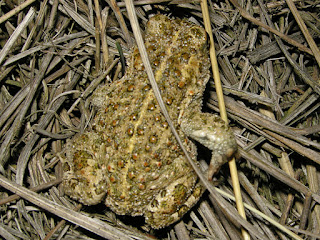Among the moths was a Saltmarsh Bell Eucosma tripoliana and a Diamond-back Moth Plutella xylostella.
Saltmarsh Bell Eucosma tripoliana, Burnham Overy, 1st August
Some Bryotropha provided interesting: one was just Cinereous Groundling Bryotropha terrella but two (one from each end of the dunes) proved to be Dull Red Groundlings Bryotropha senectella. I was more surprised by another which to me looked like a fairly pale terrella, but well within range for that species. On dissection it proved to be a Desert Groundling Bryotropha desertella.
Desert Groundling Bryotropha desertella (female, gen det), Burnham Overy, 1st August
Dull Red Groundling Bryotropha senectella (male, gen det), Burnham Overy, 1st August
There were loads of Bud Moths Spilonota ocellana (I counted 12 but I'm sure they were just the tip of the iceburg) around the Sea Buckthorn. They were all relatively dark - most of the ocellana I see seem to be yet if you look at photos online the paler form seems to be the more usual variant.
Bud Moths Spilonota ocellana, Burnham Overy, 1st August
No surprise to see Spindle Ermine Yponomeuta cagnagella after finding the Spindle trees stripped by the larvae earlier in the year.
Spindle Ermine Yponomeuta cagnagella, Burnham Overy, 1st August
Other moths seen were Dark Fruit-tree Tortrix Pandemis heparana, 2 Yellow-spot Tortrices Pseudargyrotoza conwagana, 4 Barred Grass-veneers Agriphila inquinatella, Pearl Grass-veneer Catoptria pinella, Small Grey Eudonia mercurella, Dwarf Cream Wave, Shaded Broad-bar and 2 Yellow Shells. Also 20 Cinnabar moth caterpillars.
Barred Grass-veneer Agriphila inquinatella, Burnham Overy, 1st August
Dark Fruit-tree Tortrix Pandemis heparana, Burnham Overy, 1st August
Dusk at Buirnham Overy at this time of year guarantees a chorus of Natterjack toads but it's not so often that I see them. This one was seen as it was almost dark crossing the path on the north side of the dunes.
Natterjack Toad, Burnham Overy, 1st August
At home that night it was fairly unremarkable. Two new moths for the year were the terribly named Golden Lance-wing Epermenia chaerophyllella and Straw Underwing.
Golden Lance-wing Epermenia chaerophyllella, North Elmham, 1st August
Straw Underwing, North Elmham, 1st August
Red and Dark-barred Twin-spot Carpets are supposed to be quite tough to identify with certainty, with some Red having dark bars and some Dark-barred being quite reddish. Some features once thought to be diagnostic have been shown not to be (like the notch in the bar) and the scarcer Dark-barred is sometimes said to need gen detting to confirm. It's also supposed to be quite scarce now and it's often suspected that records relate to misidentified dark-barred Red Twin-spot Carpets. Well I've found quite a few dark-barred carpets that I've dissected and they've all proved to be Dark-barred, while the few red-barred ones I've dissected have been Red. I also find Dark-barred to be consistently small-looking, though matched by a minority of presumed Red. Well this large red-barred individual wouldn't have even come inside for closer inspection had it not kept its wings firmly closed while I was emptying the trap. When it did eventually open up it just looked like a straightforward Red, albeit quite a worn one so the red wasn't as clear as it might have been when fresh. Maybe the red colour was a bit darker than normal so with it being on its last legs I decided to dissect it anyway. To my surprise this one was not a Red Twin-spot Carpet after all - it was a female Dark-barred Twin-spot Carpet! All the others I've dissected have been males so maybe females are either more variable or larger/redder?
Dark-barred Twin-spot Carpet (female, gen det), North Elmham, 1st August
Other moths were Golden Argent Argyresthia goedartella, Woundwort Case-bearer Coleophora lineolea, Cinereous Groundling Bryotropha terrella, 2 Gorse Crests Brachmia blandella, Large Fruit-tree Tortrix Archips podana, Garden Rose Tortrix Acleris variegana, Garden Grass-veneer Chrysoteuchia culmella, 32 Pearl Veneers Agriphila straminella, 2 Common Grass-veneers Agriphila tristella, Little Grey Eudonia lacustrata, 3 Mother of Pearls Pleuroptya ruralis, Gold Triangle Hypsopygia costalis, White Plume Pterophorus pentadactyla, Small Emerald, 4 Single-dotted Waves, 2 Riband Waves, Red Twin-spot Carpet, Shaded Broad-bar, Early Thorn, Scalloped Oak, Poplar Hawkmoth, 3 Yellow-tails, 4 Dingy Footmen, 7 Common Footmen, Buff Ermine, Shuttle-shaped Dart, 2 Double Square-spots, Clay, Smoky Wainscot, 2 Dark Arches, Common Rustic, 4 Uncertains, Rustic, Mottled Rustic, Nut-tree Tussock and Snout.
Golden Argent Argyresthia goedartella, North Elmham, 1st August

















No comments:
Post a Comment